“This post contains affiliate links, and I will be compensated if you make a purchase after clicking on my links.”
Last Updated on June 26, 2023
A Merle Great Dane is an incredible pet. With their beautiful coat pattern, these majestic canines are among the official coat colors of the breed.
Merle Great Danes just recently become a standard Great Dane color, and the dogs were previously not allowed to be part of dog shows. But in 2019, the American Kennel Club (AKC) and Great Dane Club of America (GDCA) both approved of the coat and officially made it a purebred color.
Find out everything you need to know about these dignified and beautiful canines in this article.
Merle Great Dane Appearance
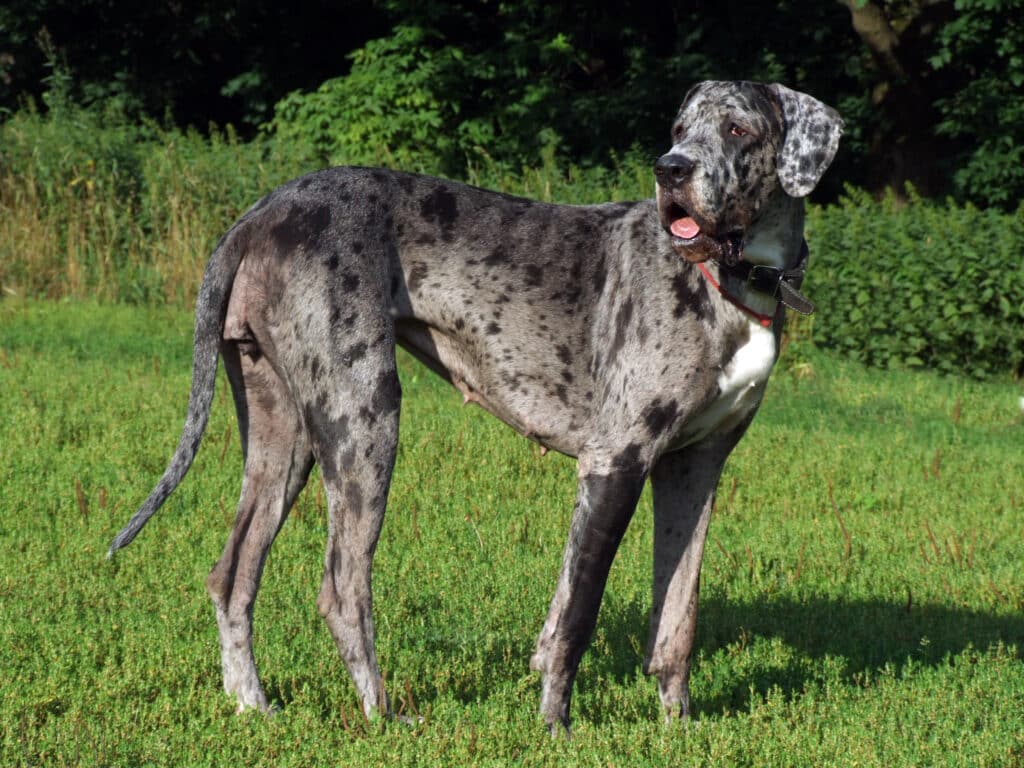
Merle Great Danes are easily distinguishable from other Great Dane colors. Their coat color is unique – they have a grey base color with black patches all throughout their body. And did you know that no two Merle Great Danes are ever the same? This is because each dog bears different patch patterns.
Usually, a Merle Great Dane puppy has a white muzzle and the tip of the tail, chest, and toes also appear black or white. And aside from the shades of grey and blue, there are also other recognized coat colors and patterns for this massive canine – a combination of white or black base coat color separated with black patches and a darker coat color which is usually grey with grey splotches.
Occasionally, the Great Dane Merle may be born with blue eyes. And sometimes, they can even be born with two or more colors in their eyes.
AKC Standards For Merle Great Danes
The Merle Great Dane was only officially recognized by the AKC as an official coat color in 2019. And AKC has strict standards for this regal dog, and they are the following:
- The coat color must be a pale gray to dark gray merle base color with black torn patches within.
- The patterns may be Solid Merle, Merle with a Mantle pattern
- The Mantle pattern may be a solid merle blanket extending over the body; merle skull with a white muzzle; white blaze is optional; whole or partial white neck; a white chest; white on whole or part of the forelegs and hind legs; white tipped merle tail. A small white break in the blanket is acceptable.
- And finally, black pigment may be seen on the skin in white areas.
The coat color was previously not considered purebred, but on January 1, 2019, the Merle Great Dane became eligible to join dog shows.
And this paved the way for Bellini, the first Merle Dane in history, to compete for the confirmation championship. This marked the paradigm shift from prohibition to acceptance for this coat color.
While Merle Danes have been accepted as an official Great Dane color, standards are very strict because Great Danes with the coat are more susceptible to a number of diseases.
Like other Merle coat dog breeds, Merle Great Danes can be prone to diseases such as deafness, blindness or even skin problems.
The Merle Coat In Dogs
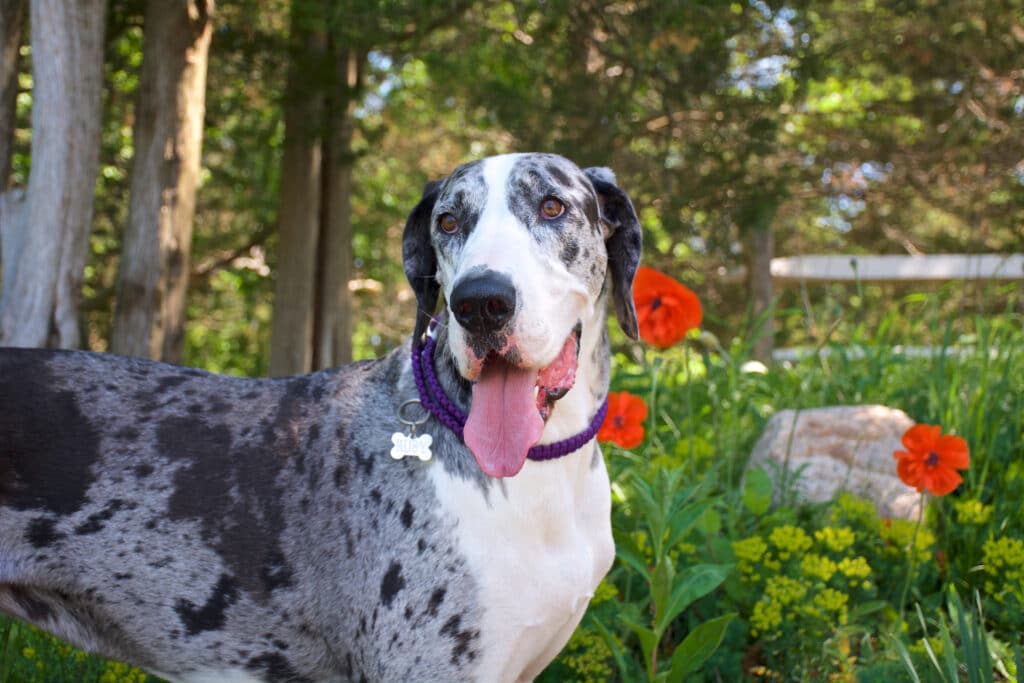
The Merle coat is considered to be one of the most intriguing and beautiful coat patterns in the pet world. No other animal has this trait, except for certain dog breeds.
The striking and unique pattern is characterized by irregular patches of color on a lighter base color. And as mentioned above, dogs with a Merle coat are often seen with blue and/or partially blue eyes. This is because the gene responsible for the Merle coat is also the one responsible for lightening the color of the dog’s iris.
Aside from the Great Dane, the Merle coat pattern is also found on:
- Australian Shepherds
- German Coolies
- Shetland Sheepdogs
- American Bullies
- Border Collies
- Dachshunds
- Cardigan Welsh Corgis
How Is The Merle Coat Inherited?
Every dog has two copies of every gene, one inherited from each parent. For a dog to have the Merle coat, they must inherit only one copy of the merle allele (M), which is a dominant gene responsible for the unique coat.
So, every Merle dog should have one copy of the merle allele (M) and one copy of the non-merle allele (m).
The Merle gene is what gives dogs more than one coat colors. It dilutes random sections of the dog’s coat to a lighter color, leaving random patches of the darker color intact.
However, as mentioned above, the Merle coat can lead to health problems. And the most common problem is hearing loss. While the chances are less than one percent, having an M allele still increases the chances of hearing loss more than those dogs that do not carry an M allele.
But what happens when a dog inherits not one, but two merle alleles (MM)?
Double Merle Great Danes
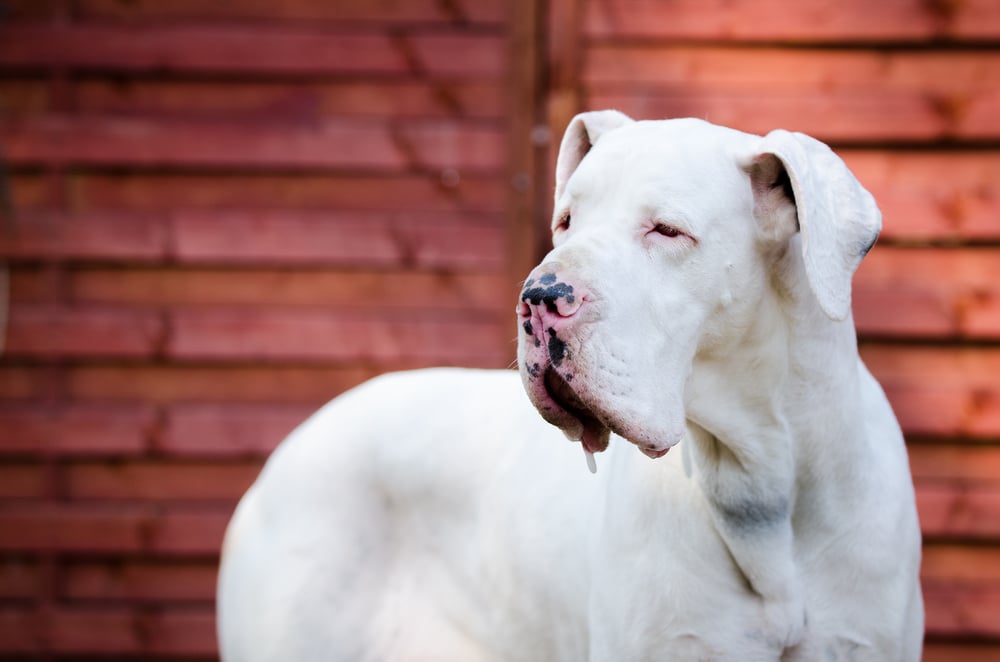
When a dog inherits two merle alleles (MM), they are referred to as “Double Merles” and commonly look nothing like standard Merle dogs.
In Great Danes, a Double Merle is commonly referred to as a White Great Dane. And they lack pigmentation in their coat. And most of the time, they have one or more complications. A healthy White Dane is not impossible to produce, but is rare.
The merle allele (M) is the gene responsible for the color of the dog’s eyes and for diluting a dog’s coat color. So, having two copies of it causes developmental defects in a dog’s eyes that lead to blindness and also the lack of hair pigment in a dog’s inner ears that increases the chances of deafness.
Double Merle Great Dane dogs are produced through bad breeding practices such as Merle to Merle and Merle to Harlequin breeding.
Merle Gene Testing In Great Danes
The decision to make the Merle Great Dane an official breed color was one that had a lot of impact in the long-held belief about their genetics.
Breeders did their best to eradicate Merles from the Great Dane breed altogether because of the dangers of Double Merles. They used the method of selective breeding, but failed to get rid of the coat pattern.
However, thanks to technological advancement and DNA testing, we can now can detect the merle allele (M) in a dog’s genetic makeup. This, in turn, help guide breeders in their decisions to ensure healthy breeding.
Nevertheless, while health issues are more common in Double Merles, they can still be found in heterozygous Merles as well. Therefore, if you are thinking of getting a Merle Great Dane, consider a reputable and responsible breeder.
Breeders hold a great responsibility to keep breeds healthy and fit. Responsible and reputable ones adhere to moral breeding norms in line of color standards that help enhance the adaptability of dogs.
Merle Great Dane Color Variations

The Merle Great Danes carry a variety of merle color patterns and variations, including:
1. Merle
This is the most common and usual Merle Great Dane color. It has a grey base coat with black patches all over the dog’s body. It is the official and and standard Merle pattern that the AKC acknowledges.
2. Blue Merle
Blue Merle Great Danes or “Dilute Merles” have a lighter, more subdued blue base coat. And they have dark, slate blue or black patches on their coat. Furthermore, their noses and other exposed skin is slate blue.
3. Cryptic Merle
A Cryptic Merle Great Dane is also known as a “Phantom Merle” or “Ghost Merle”. This is because Cryptic Merles typically display very faint merle pattern on their coats. They have inherited the merle allele (M) but appear more like solid-colored Danes.
Due to this, they are sometimes misclassified as non-merles. And these dogs, if not careful and not DNA tested, can produce double merles.
4. Mantle Merle
Mantle Merle Great Danes typically have a white base coat, mostly around their neck and chest, similar to Mantle Danes. But unlike Mantles, these dogs have black or grey patches all over their body, like Merle Danes.
Mantle Merles are not considered mismarks. As a matter of fact, they fall in the category of acceptable show colors and patterns.
Mismarked Merle Great Danes
Like all the other official Great Dane coat colors, standards must be followed and maintained for Merle Great Danes. However, mismarks are something that can’t be helped.
Mismarks are called as such because while they are just other varieties of coat colors, they do not adhere to the breed standards and are therefore not allowed to participate in dog show competitions.
However, if you just want a Merle Great Dane as a family companion, then such coat color standards do not matter. As long as, of course, the Dane is healthy.
Mismarked Merle Great Danes have other coat colors other than gray. While breed standards do not acknowledge them, they bear beautiful merle coat patterns. And in some occasions, the difference is so contrasting that the chances of finding another dog bearing a similar coat pattern as yours would be unlikely.
Continue reading below to discover these mismarks:
1. Fawn Merle Great Dane
A Fawn Merle Great Dane have a tan or brown base coat, instead of the usual grey base. And then they have grey spots all over their bodies.
2. Brindle Merle Great Dane
A Brindle Merle Great Dane has a combination of the Brindle and Merle coat pattern, which gives the dog a more muddled coat.
This mismark has a mixture of stripes and spots on its coat. So the usual black, brown, gray and red brindle stripes are not as visible and muddled together with the spots all over the dog’s body.
3. Chocolate Merle Great Dane
A Chocolate Merle Great Dane looks similar to a Fawn Merle. What differentiates this mismark from a Fawn Merle is the color of their spots. Instead of grey spots, a Chocolate Merle has chocolate-colored or red ones.
4. Merlequin Great Dane
A Merlequin or Merle Harlequin Great Dane has a striking resemblance to a standard Harlequin Great Dane. The only difference is that they do not have solid black patches on their coat. Instead, they have spots that are a combination of black and gray.
And at times, they even have less spots or have a white coat due to having two copies of the merle allele (M).
5. Orange Merle Great Dane
An Orange Merle is probably one of the rarest merle color patterns. The dog has an orange base color with gray patches all over its body. But there are also chances of visible orange spots.
This mismark can be born from breeding a Merle Great Dane with a Fawn.
6. Red Merle Great Dane
A Red Merle Great Dane bears a red hue all over its coat. It has a grey base coat, like a typical Merle, but it has darker red patches all over its body.
7. Tricolor Merle Great Dane
A Tricolor Merle Great Dane, as the name suggests, is a combination of three coat colors. Some examples of this mismark are the Blue Merle Mantle Great Dane, Fawn Merle Mantle Great Dane, and Blue Merle Harlequin Great Dane.
How To Differentiate a Merle From a Harlequin Great Dane
Merle Great Danes are sometimes mixed with Harlequin Great Danes. Here are characteristics that help differentiate a Merle from a Harlequin:
- Base coat color. The most striking difference between a Merle and a Harlequin is their base coat. Merle Great Danes have a grey base color, while Harlequins have white.
- The color of the spots. The patches on a Harlequin Great Dane’s body are black, while Merle’s patches are grey, just a shade darker than their base coat.
- Abundance of patches. The amount of patches and the pattern on the Merle Danes’ coat appear to be smaller, while bigger black patches are more common in Harlequins.
Are Merle Great Danes Rare?
Merle Great Danes are not rare, even if each Merle bears a unique coat pattern. Despite the many color and patterns they can possess, it’s fairly easy to breed Merle Great Danes.
However, there are some devious breeders who claim that Merle Danes are rare. So, be careful of them. And look for a responsible and trustworthy Merle Great Dane breeder.
Merle Great Dane Breeding
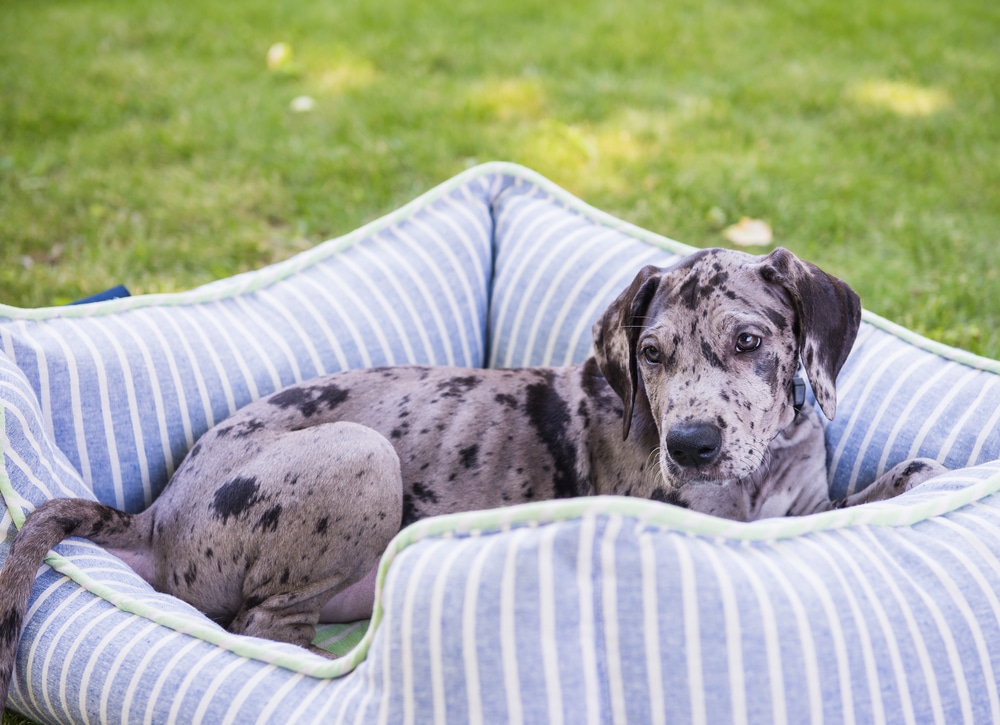
Generally, Merle Great Dane puppies are born by breeding two Harlequin Great Danes. As a matter of fact, it is almost impossible to breed Harlequins without a great probability of having at least one or two Merle Dane puppies in the litter.
Additionally, there are breeders who also breed Harlequin with Mantle Great Danes to produce Merles.
Can You Breed a Merle Great Dane?
Yes, you can. But to keep up with breed standards and make sure the lineage is fit and healthy, conducting a DNA test before breeding a Merle Great Dane is highly recommended.
Over the years, researchers have proven that Harlequin is a modification of Merle, and without the latter coat color, there wouldn’t be the existence of the former.
However, breeding Merle Great Danes without doing any homework (or DNA testing) can give birth to Double Merles or White Great Danes.
Why Is Merle To Merle Breeding Prohibited?
Breeders cannot breed two Merle Great Danes together because of the possibility of producing a litter with Double Merles. This is considered a bad breeding practice.
The breeding is strictly prohibited even if the two Merle Great Danes are physically fit. And the GDCA Breeder’s Code of Ethics even considers it as an unethical operation.
Furthermore, breeding a Merle and a Harlequin together is prohibited because it can also produce Double Merles in a litter.
Is a Merlequin Great Dane a Double Merle?
Yes, Merlequins are Double Merles. They have two copies of the merle allele (M). But they differ from White Great Danes in their genetic structure.
There is a strand of gene in a Merlequin that is different from White Great Danes. A Merlequin carries two merle alleles (M) but not the Harle gene, while a White Great Dane carries two merle alleles (M) and the Harle strand.
Being a Double Merle without the Harle strand makes the dog a bit less prone to diseases associated with the latter. Therefore, a Merlequin Great Dane is not as vulnerable as a White Great Dane.
Merle Great Dane Temperament
The Merle Great Dane has the same temperament as other Great Dane dogs. They are extremely loving and caring, hence the name ‘Gentle Giants’. And due to their loyal characteristic, they can sometimes be a bit possessive of their family.
Given the captivating temperament of the breed, these dogs are also friendly, whether its with humans or with others dogs or pets. They are amenable and gentle, and are even good with children!
Furthermore, they are moderately active canines and have a rather obedient and docile disposition.
Merle Great Dane Training
Merle Great Dane puppies are easier to train as compared to adult Merles. So training during their puppyhood is highly recommended. Although, due to their obedient and loyal disposition, training can be a bit easier even in their adult years.
These dogs will readily follow your commands and instructions. And by following a training regime regularly and persistently, you’ll be able to properly train your Merle Great Dane.
Merle Great Dane Health Issues

Great Danes, regardless of their coat color, are known to be susceptible to a number of health issues due to their enormous size. They can be prone to diseases like bloat, hip dysplasia, Wobbler Syndrome and Cardiomyopathy among others.
And to add to all of these issues, Merle Great Danes can be prone to even more life-threatening diseases if you breed two Merles and produce Double Merles.
See below to find the most common health issues Double Merle Great Danes can suffer from:
1. Hearing impairment
Double Merle dogs are often hearing-impaired. And in some cases, they can be completely deaf. As mentioned above, the lack of hair pigment in the dogs’ inner ear causes this health issue.
2. Blindness
As mentioned, the merle allele (M) is also responsible for the color of a dog’s eye. And when a dog has two copies of the merle allele, this results to the eyes’ lack of pigment that then leads to blindness.
Other Eye Problems
Merle Great Dane dogs do not only suffer from partial or total blindness, they can also be born with other eye-related problems like:
- Optic nerve weakness
- Small eyeballs (Microphthalmia)
- Misplaced pupils and lens
- Abnormal eye development including the iris and retina
3. Skin Cancer
Since Double Merles lack pigment in their coat, they are more prone to sunburns and skin cancer. They do not have a protective pigment (or melanin) to protect them from UV exposure.
Our Take
Merle Great Danes are perfect companions for families. Aside from their beautiful coat pattern, they have the characteristic and temperament a family will absolutely adore – big, loving, social and loyal.
So, if you are considering a Merle Great Dane, try to look for reputable breeders, particularly those who adhere to standard breeding practices. Do not forget to ask for the pup’s health record to know its lineage. In this way, you can secure a fit pup even if it has Merle gene strand.
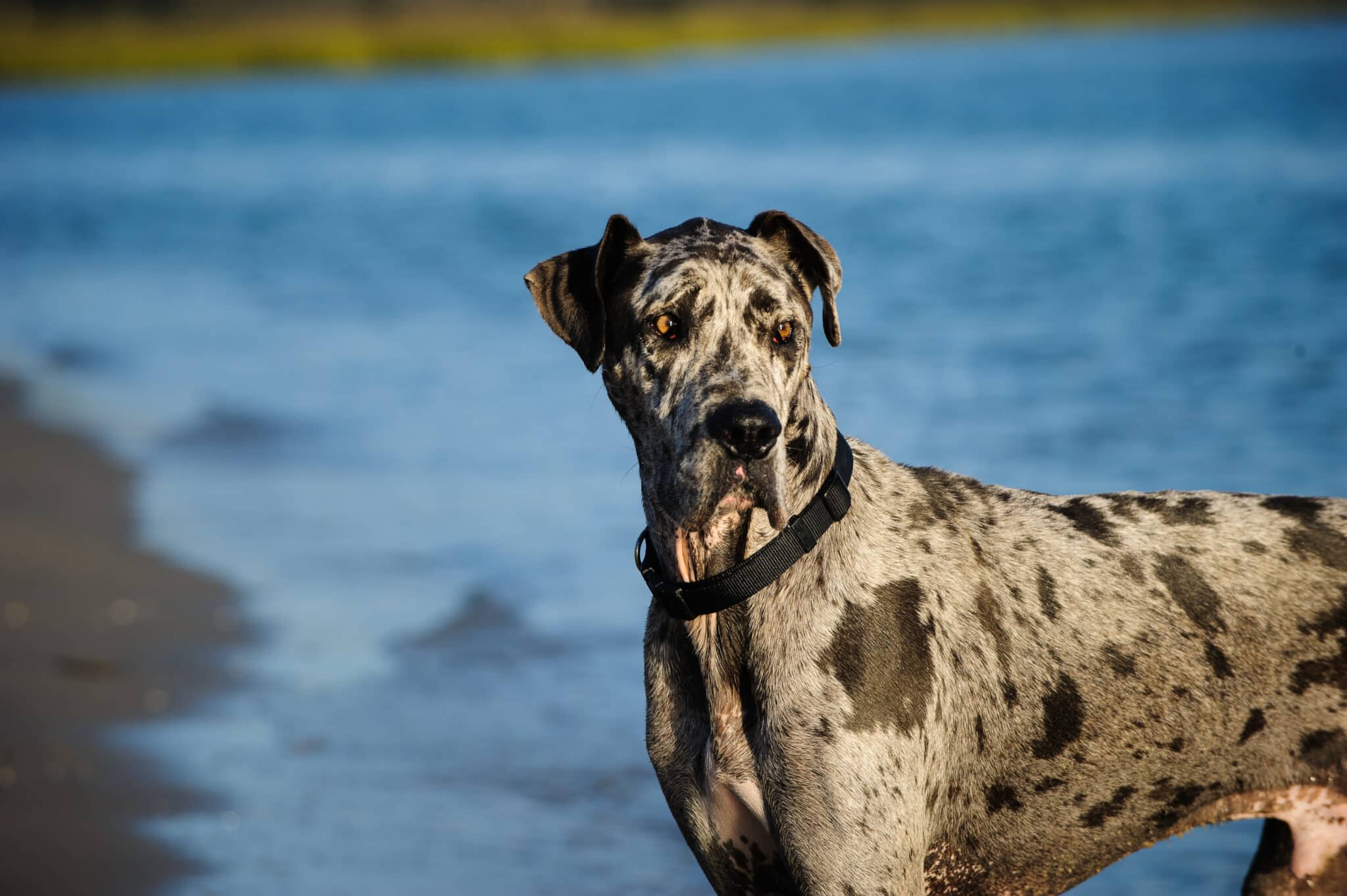
Hello,
With the addition of Merle as an accepted colour with the Great Dane Club of America (New accepted colour list coming soon) I ask if you need to update your strong stance on breeding Merles? The code of ethics at the GDCA no longer includes a statement that breeding Merles is unethical.
We appreciate your support Leslie to keep our website up to the minute.
Hi, what are the health risks of breeding a Brindle Harlequin ( Brindlequin) to a Merlequin? Can this be considered Merle to Merle breeding? Is a Brindlequin likely to have the Merle gene? Sorry, too many questions at once